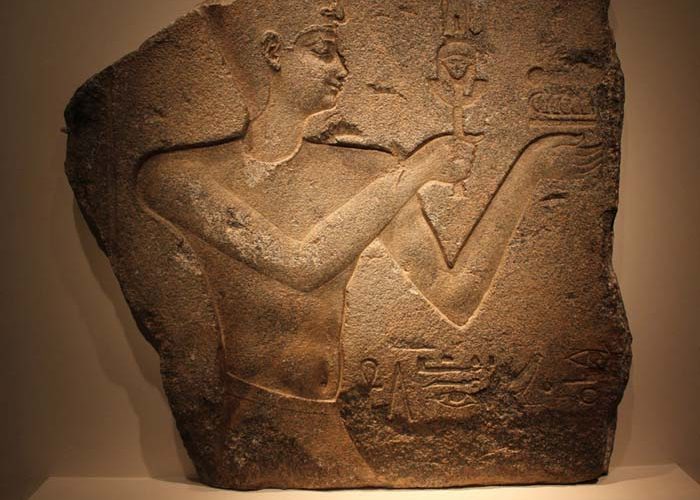At first, nothing existed except Nun, the celestial waters. Ra sprang from Nun with words on his lips and those words created the first firmament. Then he created his daughter Tefnut from his spit and his son Shu from his breath. They lived together until Tefnut and Shu wandered away and Ra missed them. He plucked out his eye and sent it to find his children. Then Ra created a new eye for himself so he would be able to see his children.
© kairoinfo4u – Ceiling at Dendera Temple, describing the creation of the world
The old eye found Tefnut and Shu and brought them back to Ra who cried with joy. His tears fell and created the first humans. The old eye was jealous of Ra’s new eye, so Ra turned the old eye into the first cobra and wore it on his forehead. Tefnut and Shu mingled together and gave birth to Geb and Nut. Shu separated his children to form the sky, Nut, and the earth, Geb. Ra became a ball of fire and rolled over Nut creating the pattern of day and night. After this, all other creatures and all plants came into being.
The Importance of the Gods in Ancient Egypt’s Daily Life
Daily rituals took place at the local temples to care for the gods which, the king or a high priest conducted. As part of the ritual, the king or priest washed the image of a certain god, clothed it in fresh garments, and gave it a meal. The meal consisted of various kinds of meat and vegetables which the priest shared with the temple staff after the ritual. Burnt offerings were a rarity in ancient Egypt.
Festivals were a time for everyone to worship the gods and goddesses of ancient Egypt. Images of the gods progressed through the city in a barque, a small boat. The common people gathered in the outer courtyard of the temple and gave offerings. People offered flowers because they represented life, as well as food and drink. The priests gave portions of the food offerings to the common people. Many festivals to the deities took place throughout Egypt and were a public holiday.
Relief of Ptolemy II with ritual rattle
Private individuals served the gods in various ways. Many private homes had shrines where the family worshiped household gods. These gods protected the home and its occupants. Common people also presented votive offerings to the gods at their local temples. Votive offerings were statuettes, steles, or carved plaques that included a prayer to the god or a hymn praising the deity. Worshipers placed these offerings in the main courtyard of the temple. When the priests needed more room to place them, they buried the votive offerings in pits. These pits have provided scholars with information about the worship of the common people. Votive offerings show the rise in personal piety among the people of ancient Egypt.
Another important part of worship involved the offerings to the dead. Relatives would offer bread, beer, oxen, birds and clothing to the god Osiris. They included prayers with these offerings so the god would share them with their dead relatives. There were special altars designed to accept these offerings.
People also interacted with the gods through oracles, prayers and hymns. During the processions of the ancient Egyptian gods, people would write a question on a piece of pottery or papyrus. A person placed the question before the god’s image. The god compelled the priests carrying the barque to move forward or backward to show a yes or no answer. People wrote prayers to the gods to ask for protection or to honor the gods. Hymns honored the gods by praising their deeds or their beauty.
Specific people conducted the religious ceremonies in the temples. Many wall carvings show the king caring for the god’s image and conducting ceremonies. Records state that the king did conduct ceremonies but he could not serve every deity. The High Priest of the temple would conduct ceremonies in the king’s place. During the 21st Dynasty, the role of ‘god’s wife of Amun’ became a powerful priestess position. Over time, these women came to present offerings to the gods and to conduct ceremonies.
